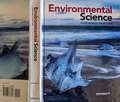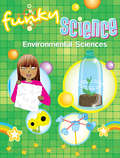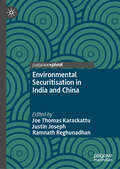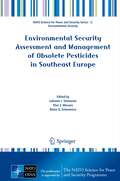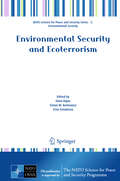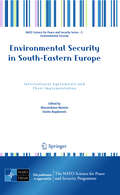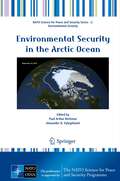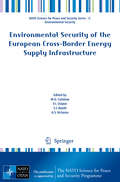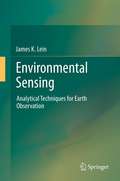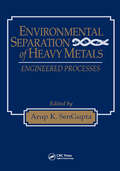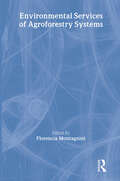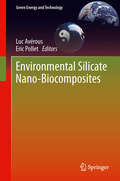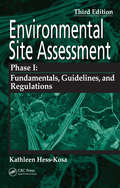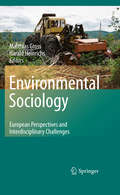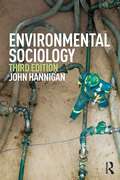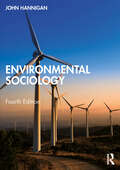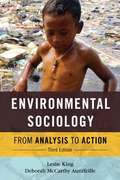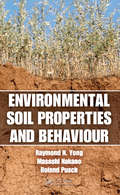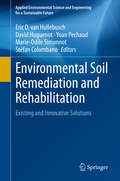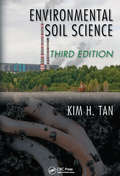- Table View
- List View
Environmental Science: Working with the Earth
by G. Tyler Miller Jr.With an emphasis on the concept of sustainability, this interdisciplinary textbook looks at how nature works and how things in nature are interconnected. Material from science, economics, political science, and environmental ethics is integrated throughout the text. Some 80 brief case studies illustrate specific environmental problems and explore possible solutions. New topics covered in the 11th edition include reconciliation ecology, ownership of water resources, and bioterrorism. Annotation ©2005 Book News, Inc. , Portland, OR (booknews. com)
Environmental Science: Working with the Earth (11th edition)
by G. Tyler MillerThis edition places increased emphasis on science-based approaches that interact with political solutions to address environmental problems, offers greater integration of economic and environmental topics, and stresses the shift from large centralized sources of power to a dispersed array of smaller micropower plants. There are two new chapters on community ecology and geology, and expanded coverage of aquatic biodiversity. Tyler is president of Earth Education and Research, and professor of human ecology at St. Andrews Presbyterian College.
Environmental Science: Your World, Your Turn
by Jay WithgottPhenomena drives student engagement in the all new Environmental Science - coming Back to School 2020! An Anchoring Phenomena launches scientific inquiry in every topic supported by a Claim-Evidence-Reasoning activity and Problem-Based Learning project.Students make sense of the Anchor with 19 Investigative Phenomena Case Studies. These authentic, real-world applications of Environmental Science excite students and inspire their passion for the environment.
Environmental Sciences Funky Science (Funky Science)
by Kirsten HallSmart and savvy girls will love discovering the secrets of science! Funky Science: Environmental Sciences has loads of cool, creative experiments presented in a fun and accessible way, relating to topics that girls love. Go green as you learn about plants, save the planet as you compost and recycle, uncover the wonders of weather, and explore the world of Environmental Sciences! All experiments are developed with science teachers and provide the science behind the activity along with parental guidance symbols and glossaries of Wonder Words.
Environmental Securitisation in India and China
by Joe Thomas Karackattu Ramnath Reghunadhan Justin JosephThis book examines how emerging environmental challenges are situated within existing International Relations (IR) theoretical understandings of &‘security&’. As governments in the Global South undertake policy interventions to mitigate the impact of increasing climatic changes and yearn to achieve human-nature harmony, one can observe similar patterns of responses chiefly due to the ecology-economy dichotomy in these states and their societies. In this context, it brings to the readers various aspects of the theory and practice of state interventions in the form of environmental securitisation in the Global South majorly under four themes (encompassing theory and policy processes). Chapters in this volume explicate connections between the environment and International Relations Theory, securitisation in developing countries, state society and the environment in India and China and lastly, public participation and environmental policymaking. It presents a comprehensive and coherent overview of the politics of securitisation in India and China, two prominent economies in the Global South. Faculty and researchers who work on non-western International Relations theory and non-traditional security threats, policy practitioners and experts in environmental policymaking, and students of IR and Comparative Politics, chiefly, will benefit from this book.
Environmental Security Assessment and Management of Obsolete Pesticides in Southeast Europe
by Biana G. Simeonova Fliur Z. Macaev Lubomir I. SimeonovThe present work is a fine contribution to the broad field of environmental security in the context of risk assessment and management of obsolete pesticides for the region of Southeast Europe. The purpose of this book is to evaluate the existing knowledge of improper disposal of obsolete pesticides in the region, to estimate the associated impact on environmental health, and to develop recommendations to mitigate or eliminate threats posed to the environment, biodiversity and human life. The issues discussed in the book include: reviews of the transport and fate of pesticides and associated contaminated materials in different environmental media and identification of the principal sources, emission routes and patterns of environmental pollution with pesticides; a recognition of the most suitable methods for environmental sampling analysis and sample preparation; an evaluation of the current methods and techniques for chemical and mass analysis of environmental and biological samples and discussion of the metrological and quality aspects of trace analyses; a characterization of the environmental and human health impacts of pesticide pollution, the health effects associated with acute and chronic exposure and the use of epidemiological data for risk assessment; a revision of the existing chemical safety regulations and strategies for protection and management of obsolete pesticide stocks; a survey of the international conventions, directives and standards concerning pesticide use.
Environmental Security and Ecoterrorism
by Hami Alpas Simon M. Berkowicz Irina ErmakovaIn recent years, the concept of environmental security has been adapted to include preparedness for acts of ecoterrorism. This latter term has now become synonymous with environmental terrorism where the perpetrator uses the environment as a weapon to harm an opponent. The intended outcome is usually large-scale deaths, severe damage to the environment, and instilling fear in the general population. This book explores various facets of ecoterrorism including the role of the state in pursuing and maintaining environmental security, a review of the concept of ecoterrorism, food security challenges and weaknesses, technological countermeasures to enable rapid detection or response, and existing pollution sources and hazards that may serve as targets for terrorist acts. In sum, this volume provides a useful overview for both the layperson and experienced researchers.
Environmental Security in South-Eastern Europe
by Massimiliano Montini Slavko BogdanovicAuthored by international experts from academia, international organizations, governments and NGOs, this book highlights the main environmental security issues in the South-East European (SEE) countries, with a particular focus on climate change and water management. The common goal of the authors was to provide a reliable evaluation of whether existing legal regimes and correct implementation of applicable international treaties may contribute to reducing environmental security risks in the region. In-depth analyses and assessment of major challenges in compliance, serve as a firm ground which such evaluation is based on. This volume is recommended for public officials, legal practitioners and consultants. Its interest may also extend beyond the SEE countries, serving as a case-study of a broader and paradigmatic relevance of the analysis and management of environmental and security issues in a trans-boundary context.
Environmental Security in Watersheds: The Sea of Azov
by Viktor LagutovWatersheds, supplying crucial ecosystem services to humans, seem to be a logical territorial unit to integrate societal benefits and environmental needs in order to evaluate the sustainability of natural resource use patterns. Based on this belief the book is an attempt to initiate a comprehensive environmental security assessment in the basin of the Azov Sea, shared by Russia and Ukraine. Though the region provides a variety of essential services and plays a strategic role in national and international development plans, it has been excluded from most regional environmental discussions. At the same time there is an alarming degradation rate of basin freshwater ecosystems that has occurred due to overutilization of certain prioritized services (e.g. transportation). The collapse of neglected services (e.g. fishery and freshwater supply) poses serious threats to the national economies as well as the local population, and to mitigate these threats priority in water management should be given to securing sustainability of the regional freshwater ecosystems. In addition to the review of the current status of Azov ecosystem services, the authors analyze likely future availability and challenges. The relevant experience derived from basin management of the Black Sea and other similar basins is also discussed.
Environmental Security in the Arctic Ocean
by Paul Arthur Berkman Alexander N. VylegzhaninThis seminal book results from a NATO Advanced Research Workshop at the University of Cambridge with Russian co-directorship, enabling the first formal dialogue between NATO and Russia about security issues in the Arctic Ocean. Involving interdisciplinary participation with experts from 17 nations, including all of the Arctic states, this workshop itself reflects progress in Arctic cooperation and collaboration. Interests now are awakening globally to take advantage of extensive energy, shipping, fishing and tourism opportunities in the Arctic Ocean as it is being transformed from a permanent sea-ice cap to a seasonally ice-free sea. This environmental state-change is introducing inherent risks of political, economic and cultural instabilities that are centralized among the Arctic states and indigenous peoples with repercussions globally. Responding with urgency, environmental security is presented as an "integrated approach for assessing and responding to the risks as well as the opportunities generated by an environmental state-change." In this book - diverse perspectives on environmental security in the Arctic Ocean are shared in chapters from high-level diplomats, parliamentarians and government officials of Arctic and non-Arctic states; leaders of Arctic indigenous peoples organizations; international law advisors from Arctic states as well as the United Nations; directors of inter-governmental organizations and non-governmental organizations; managers of multi-national corporations; political scientists, historians and economists; along with Earth system scientists and oceanographers. Building on the "common arctic issues" of "sustainable development and environmental protection" established by the Arctic Council - environmental security offers an holistic approach to assess opportunities and risks as well as develop infrastructure responses with law of the sea as the key "international legal framework" to "promote the peaceful uses" of the Arctic Ocean. With vision for future generations, environmental security is a path to balance national interests and common interests in the Arctic Ocean for the lasting benefit of all.
Environmental Security of the European Cross-Border Energy Supply Infrastructure
by V. I. Osipov M. G. Culshaw S. J. Booth A. S. VictorovThe current volume provides examples of how environmental hazards such as landslides, earthquakes, mountain processes, cold climate processes and tidal flows and currents can affect the energy supply infrastructure. In times of uncertainty, the security of the European cross-border energy supply infrastructure, such as pipelines, has great importance. Whilst the potential effects of political disagreement, economic inequalities and social differences are relatively well understood, the impact of environmental change is often poorly appreciated by decision-makers. New approaches have been examined for monitoring of hazardous landslide processes, including early warning systems, and near-real-time 3D data processing and visualization. The scientific problems of environmental systems design have been discussed and approaches for their implementation have been suggested. New integrated remote sensing techniques consisting mainly of hyperspectral and radar imagery are presented together with the processing of monitoring data using GIS techniques and, in particular, dynamic visualization. Attention is also given to conceptual issues of environmental and energy security and the role of education, to help resolve environmental problems through cooperation in the development of the European energy supply infrastructure.
Environmental Sensing
by James K. LeinRemote sensing has witnessed a renaissance as new sensor systems, data collection capabilities and image processing methodologies have expanded the technological capabilities of this science into new and important applications areas. Perhaps nowhere has this trend been more evident than in the study of earth environments. Within this broad application area remote sensing has proven to be an invaluable asset supporting timely data gathering at a range of synoptic scales, facilitating the mapping of complex landscapes and promoting the analysis of environmental process. Yet remote sensing's contribution to the study of human/environmental interaction is scattered throughout a rich and diverse literature spanning the social and physical sciences, which frustrates access to, and the sharing of the knowledge gained through, these recent advances, and inhibits the operational use of these methods and techniques in day to day environmental practice, a recognized gap that reduces the effectiveness of environmental management programs. The objective of this book is to address this gap and provide the synthesis of method and application that is currently missing in the environmental science, re-introducing remote sensing as an important decision-support technology.
Environmental Separation of Heavy Metals: Engineering Processes
by Arup K. SenGuptaThis new book explains advanced and emerging technologies for removing heavy metals from wastestreams and contaminated sites. Separation processes of this type are critical for meeting stringent regulations of priority pollutants, especially arsenic, mercury, and lead, which the text treats in depth. After explaining the chemistry of heavy metals a
Environmental Services of Agroforestry Systems
by Florencia Montagnini Yale UniversityGet cutting-edge agroforestry research and dataDeforestation and the rampant use of fossil fuels are major contributors to increases in atmospheric carbon dioxide and are enormous influences on global warming. Agroforestry systems and tree plantations can help mitigate the resulting climate change and degradation of biodiversity and accelerating climate change. Environmental Services of Agroforestry Systems addresses these global concerns with an essential collection of presentations on biodiversity and climate change from the First World Congress in Agroforestry (Orlando, Florida, 2004). Respected experts discuss the latest research and data on how agroforestry systems can help solve environmental problems through carbon sequestration and biodiversity conservation.Years ago, agroforestry’s environmental benefits were mainly seen as being soil amelioration, erosion control, microclimate control, and the alleviation of the effects of drought in semiarid areas. Environmental Services of Agroforestry Systems goes beyond the regional considerations of years past to focus on the challenges of today’s most pressing global environmental concerns. The contributors describe the latest research and concepts in agroforestry systems, reforestation efforts, soils, vegetation, and agriculture while reviewing their economic aspects. Incentives for reforestation and agroforestry are explored in detail. Each chapter is carefully referenced and includes tables to clarify ideas and data.Environmental Services of Agroforestry Systems addresses: advantages of mixed-species plantations tropical pasture and silvo-pastoral systems tropical forest ecosystem management research on the economic feasibility of various land-use systems socio-economic considerations of coffee-growing ecosystems agroforestry systems in Costa Rica Environmental Services of Agroforestry Systems is essential reading for researchers and scientists, as well as professionals in agroforestry, forestry, soils, global change, climate change, and environmental studies, educators, and graduate and undergraduate students.
Environmental Silicate Nano-Biocomposites
by Luc Avérous Eric PolletEnvironmental Silicate Nano-Biocomposites focuses on nano-biocomposites, which are obtained by the association of silicates such as bioclays with biopolymers. By highlighting recent developments and findings, green and biodegradable nano-composites from both renewable and biodegradable polymers are explored. This includes coverage of potential markets such as packaging, agricultures, leisure and the fast food industry. The knowledge and experience of more than twenty international experts in diverse fields, from chemical and biochemical engineering to applications, is brought together in four different sections covering: Biodegradable polymers and Silicates, Clay/Polyesters Nano-biocomposites, Clay/Agropolymers Nano-biocomposites, and Applications and biodegradation of Nano-biocomposites. By exploring the relationships between the biopolymer structures, the processes, and the final properties Environmental Silicate Nano-Biocomposites explains how to design nano-materials to develop new, valuable, environmentally friendly properties and uses. The combination of fundamental and applied science makes this an ideal reference for a range of readers from students and lecturers to material and polymer scientists and even industrial engineers who are interested in bringing new environmental nano-materials to the current market.
Environmental Site Assessment Phase I: A Basic Guide, Third Edition
by Kathleen Hess-KosaExtensively updated, this third edition provides a valuable guide to the tools and techniques used to perform Phase 1 site assessment. This book elucidates the systematic processes and methods used by leaders in the industry. It also emphasizes the development of an easy-to-follow investigative strategy for in-house assessment. After reviewing the history of the field, legal issues, and important terms, the book discusses physical setting, historic usage, property and area reconnaissance, building materials, and industrial activities associated with a property. It also gives interviewing tips, lists regulatory agencies, and considers unique situations such as wetlands and historical buildings.
Environmental Sociology
by Harald Heinrichs Matthias GroßDespite being a relatively young sub-discipline, European environmental sociology has changed considerably in the last decades towards more interdisciplinary collaborations and problem solving. Current trends such as global environmental modernization and processes of economic, political and socio-cultural globalization, fuelled by developments of transport, environmental flows, scientific uncertainty, and information technologies, have fostered new conceptual approaches that move beyond classical sociological mind-sets toward broader attempts to connect to other disciplines.
Environmental Sociology
by John HanniganThe third edition of John Hannigan’s classic undergraduate text has been fully updated and revised to highlight contemporary trends and controversies within global environmental sociology. Environmental Sociology offers a distinctive, balanced treatment of environmental issues, reconciling Hannigan’s much-cited model of the social construction of environmental problems and controversies with an environmental justice perspective that stresses inequality and toxic threats to local communities.
Environmental Sociology
by John HanniganJohn Hannigan’s definitive textbook offers a distinctive, balanced coverage of environmental issues, policies and action. This revised fourth edition has been expanded and fully updated to explore contemporary developments and issues within global environmental sociology. Environmental Sociology reconciles Hannigan’s widely cited model of the social construction of environmental problems and controversies, which states that incipient environmental issues must be identified, researched, promoted and persuasively argued in the form of "claims", with an environmental justice perspective that stresses inequality and threats to local communities. For example, this new edition explores the interconnections between indigenous communities and environmental activists via a study of the difficult relationship between Aboriginal people and environmentalists in Australia. The updated fourth edition also discusses new direct action protest groups, such as Extinction Rebellion, who have reframed the discourse around the "climate emergency" using apocalyptic language and imagery. Environmental Sociology also signposts exciting new directions for future research. The fourth edition re-interrogates the classical roots of environmental theory with a focus of the work of Alexander von Humboldt. Hannigan also asserts the need for environmental sociologists to turn their attention to "The Forgotten Ocean", arguing that the discipline should incorporate cutting-edge concepts such as marine justice, striated space and volumetrics. Environmental Sociology is a key text for students and researchers in environmental studies, political ecology, social geography and environmental sociology.
Environmental Sociology: From Analysis To Action
by Leslie King Deborah AuriffeilleEnvironmental Sociology encourages students to use the sociological imagination to explore a broad spectrum of issues facing the environment today. The third edition of this reader includes thirteen new pieces that examine how social dimensions, particularly power and inequality, interact with environmental issues. <p><p> The textbook opens with an updated introduction that introduces students to key concepts and provides a brief overview of environmental sociology as a field. The readings, excerpts from recently published pieces, are arranged by sociological issue and use a range of perspectives, including environmental justice, risk society, and power structure research. Topics span coal mining, food justice, climate change, and more. Each reading is chosen to be accessible and engaging to undergraduate students and is preceded by a brief introduction to provide context. <p> As the environmental challenges facing our world become ever more pressing, Environmental Sociology aims to equip students with the frameworks they need to approach these challenges from a sociological perspective.
Environmental Soil Properties and Behaviour
by Roland Pusch Masashi Nakano Raymond N. YongFrom bridges and tunnels to nuclear waste repositories, structures require that soils maintain their design engineering properties if the structures are to reach their projected life spans. The same is true for earth dams, levees, buffers, barriers for landfills, and other structures that use soils as engineered materials. Yet soil, a natural resou
Environmental Soil Remediation and Rehabilitation: Existing and Innovative Solutions (Applied Environmental Science and Engineering for a Sustainable Future)
by Eric D. van Hullebusch David Huguenot Yoan Pechaud Marie-Odile Simonnot Stéfan ColombanoThis book provides a comprehensive overview of innovative remediation techniques and strategies for soils contaminated by heavy metals or organic compounds (e.g. petroleum hydrocarbons, NAPLs and chlorinated organic compounds). It discusses various novel chemical remediation approaches (in-situ and ex-situ) used alone and in combination with physical and/or thermal treatment. Further, it addresses the recovery of NAPLs, reuse of leaching solutions, and in-situ chemical reduction and oxidation, and explores the chemical enhancement of physical NAPLs recovery from both practical and theoretical perspectives. Also presenting the state-of-the-art in waste-assisted bioremediation to improve soil quality and the remediation of petroleum hydrocarbons, the book is a valuable resource for students, researchers and R&D professionals in industry engaged in the treatment of contaminated soils.
Environmental Soil Science (Books in Soils, Plants, and the Environment)
by Kim H. TanCompletely revised and updated, incorporating almost a decade's worth of developments in this field, Environmental Soil Science, Third Edition, explores the entire reach of the subject, beginning with soil properties and reactions and moving on to their relationship to environmental properties and reactions. Keeping the organization and writing sty


